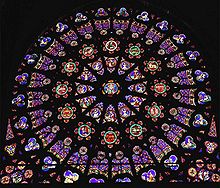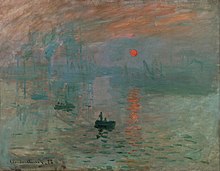User:Sharkrose/sandbox
French Decorative Styles[edit]
French Decorative Art was birthed from the fall of the Western Roman Empire in the 5th Century[1]. With the implementation of Charlemagne's military skill, France abandoned anarchy and savage tribes for a more modern France[1]. The beginning of the French architectural and decorative life and replaced the ancient remnants of Roman conquests[1]. French Decorative Styles considers the the biggest and most popular facets of french decoration including Architecture, Interior Design and Art that have taken place throughout French history and in current times. Interior design examines colours, themes, decor, furniture, textiles and drapery. Much of France's rich history has had major influences on its designs and styles. Its decorative forms are typically unique and chic with timeless elegance[2].
French Romanesque (476-1150)[edit]
Architecture[edit]
Interior Design[edit]
French Rococo (1715 - 1774)[edit]
Architecture[edit]
Interior Design[edit]
Directoire (1795-1799)[edit]
Architecture[edit]
Interior Design[edit]
Empire (1804-1830)[edit]
Architecture[edit]
There was never a fully unified architectural style, as Napoleon Bonaparte did not stay in power long enough after the French Revolution[3]. It mostly embodied a revival of Greek and Roman neoclassical architecture[4]. The propagandistic manner of the Empire style liberated architecture which intended to reflect the way that Napoleon liberated France and Europe[3].
Interior Design[edit]
The Empire Design succeeded and elaborated the Directoire, and had a central focus on Napoleon himself, who sought to eradicate the Louis Art Style after the French Revolution[1]. It epitomised his vanity and ambition and was developed from his desire as a new emperor to have a new style which imitated ancient Roman imperial designs[1]. This stylistic movement was enforced in aims of idealising the French Empire, through predominantly propagandistic elements[5]. Decorative elements took on empirical designs with military motifs and depicted victorious battle scenes in embroidery, drapery and war trophies[3]. The Empire style incorporated the colours of deep browns, rich greens, reds and noble blues and purples[1]. This movement lacked any true originality as it was built of imitations of the ancients and hence, was not able to be further developed into another decorative style[1]. Decor inspired by ancient Romans, included torches, eagles, stars, garlands, and mythological signs such as the helmet of Minerva and thunderbolts of Jupiter[1]. Drapery had majestic folds created from heavy materials from embroidery and woven fabric, which created a classic noble look[1]. Beds were low and heavy with equal heights for headboards and footboards and had four-posters[1]. Plain stripes were used for wall decoration[1]. Overall, the empire style is stiff, severe and cold and its attractiveness lies in its uniformity[1]. Most furniture was made into classical shapes with brass mounts or woods inlaid with ivory and metal[1]. The favoured woods used in furniture were mahogany, rosewood, and ebony[1].
Minimalism/Modernism[edit]
Architecture[edit]
Interior Design[edit]
L'Art Nouveau[edit]
Architecture[edit]
Interior Design[edit]
French Provincial[edit]
Architecture[edit]
The French provincial architectural style that was influenced by the characteristics of rural countryside France[6] in the 17th and 18th centuries[7]. These homes are quite stately with a country casual elegance[6] and have distinctive features in their design including symmetry, balance, high ceilings, steeped roofs, brick or stone exterior, french windows and shutters[6], and second story windows which give way to more height[7]. The highly steeped roofs afford their appeal to the beautiful slate [8] which are often hipped, where all sides of the roof slope downwards[9]. Most provincial roofs include dormers, which are small protrusions from the roof which have windows[9]. French provincial architecture is used for residential purposes, and was built by French aristocrats from provinces such as Normandy, Brittany and Provence[9]. Because of its emphasis on balance and symmetry, it is usual to see equal number of windows on either sides of a building with an arched middle entrance[9]. French provincial design for houses is quite common throughout the United States and was introduced after soldiers returning from the First World War had seen and admired these houses in the French provinces[8]. With their high ceilings, they have tall stories and are often two to three stories high[9]. Most windows are simple and bare, with at most, some shutters embellishing the windows on the outside[7]. These homes also feature tall, slim rectangular chimneys[7].
Interior Design[edit]
French provincial design mirrors the architectural design of homes in french provinces in 17th and 18th centuries[10]. This style of design is defined by aesthetics of simplicity and understatement[7] yet casually elegant[6]. The colour palette used in French provincial design is often inspired by the surrounding environment, with tones of earthy greens, blue and rusty reds but utilised white and cream as foundational colours[10]. Texture is an important element of this decorative style, and can be seen with unfinished wood, natural stone floors, iron and stone accents, distressed ceiling beams, roughly plastered walls and lots of wooden details in furniture[6] [10]. Soft and curved edges and lines are used to create elegance and refute any styles of minimalism[6]. An essential feature is a wood fireplace and mirrors that reflect light around the room[10]. Furniture that has smooth edges such as grand armoires, buffets and round farmhouse tables are central to this style. Textiles such as embroidered pillows, draperies and linens play tribute to the French working female class of the 17th and 18th century[10]. A famous french fabric, Toile de Jouey, a cotton or linen fabric is utilised for upholstery in furniture[10]. Decorative accessories such as rustic baskets, old copper pots, ceramics and flowers add to the aesthetic of the provincial design[10].
See also French Provincial Furniture
Art[edit]
Stained Glass Windows[edit]

Much of what we know about the creation of Stained Glass Windows, also known as vitrails, during the Gothic period is afforded to primary written records from people such as German monk, Theophilus's work 'On various Arts'[11]. His works held comprehensive records of how stained glass windows were made from a heated mixture of sand and potash which was heated to a point that they liquified and turned into glass when cooled[11]. The colour of the glass is made from powdered metals which are combined with the molten sand and potash before it gets cooled into glass[11]. These stained glass pieces are put together in a mosaic stabilised by iron frames and utilise black paint for shadows and fine detailing[11]. Stained glass artistry peaked during the 13th Century and was a key facet of gothic architecture[12]. Most stained glass depicts Biblical scenery and are found most commonly in French-Gothic cathedrals[13]. There was a decline in the 17th century of the frequency of stained glass windows however was revived with the Anglo-Catholic resurgence that occurred in the 19th century[12]. Examples of these French-Gothic cathedrals include, the Chartres Cathedral, Notre Dame de Paris, Notre Dame de Reims and Saint Chappelle[13]. Many of these cathedrals were destroyed during major world events such as the French Revolution and the World Wars[13]. These medieval stained glass windows that had to undergo restoration throughout history began to incorporate and include more Renaissance and modern styles to details as restorations were implemented[13].
Artistic and Stylistic Movements[edit]
These are the largest and most famous stylistic movements in French art history[14].
Neoclassicism[edit]
Neoclassicism was a very dominant stylistic movement through the period of 1780-1900[14]. Its emergence was birthed from the discovery and excavation of the ancient sites in Italy, Herculaneum and Pompeii and thrived under the Napoleon empire[14]. Its elements comprised of an obsession with the idealised forms and concepts of Ancient Greek and Roman mythologies[15]. Neoclassicism had a focus on presenting order and balance which was heavily influenced by the current ongoing French Revolutions[15]. This painting style was politically driven[16] and honoured values of austerity, heroism and stoicism which had much to do with the cultural values of liberty motivated by the French Revolution[17]. Notable artist Jacques-Louis David, belonged to the period of this stylistic movement[17] which had major influences on other stylistic painting forms[15].
Romanticism[edit]
Romanticism emerged as a reaction to the Industrial Revolution and emphasised the tenets of emotional, imaginative and personal aspects of life and nature[14]. This artistic movement rejected the order and idealisation of Neoclassicism and had a heavy emphasis on appreciation and beauty of nature, emotions and sensory experiences[14].
Realism[edit]
Realism was a response to the post-revolution in which the desire for egalitarianism increased[15]. It focused on portraying unidealised elements of hard reality like depictions of poverty and struggle[15]. It aimed to appeal beyond just high-class elites to general lower-class public[14]. It avoided dramatisations and fantasies and aimed to celebrate the working classes[14].
Impressionism[edit]

Impressionism was born from a radical group of Parisian painters[14]. This movement avoided any emphasis on deep meanings, significances and symbols, and hence was just an impression[14]. Examples of impressionism included landscape artworks[14] and was quite experimental with depictions of new modern world[15].
Post-Impressionism[edit]
Post-Impressionism was quite predominant in France[14]. It developed as a response from artists' displeasure with blurred, imprecise facets of Impressionism[14]. It had the aims of restoring the sense of order and structure that had been lost in painting history by incorporating elements of rich symbolism and emotion[14]. Reputable painter Paul Cezanne flourished during this period, with post-impressionist artworks of vivid, bright colours and patterns[15]. This stylistic movement paved the way for the modernist movement.
See Also[edit]
References[edit]
- ^ a b c d e f g h i j k l m n Butler, Ellis Parker; Wilson, Brittain B. (1904). The French Decorative Styles; from the earliest times to the present day. New York, T.A. Cawthra & Co.
- ^ "French Style". Lavender Hill Interiors. Retrieved 2019-05-10.
- ^ a b c Kovalchenko, Anna (2016). History of Styles, English and French Styles 17th to 21st century. L’Essenziale.
- ^ "French Empire Style Architecture". Study.com. Retrieved 2019-05-21.
- ^ "The Empire Style | Boundless Art History". courses.lumenlearning.com. Retrieved 2019-05-21.
- ^ a b c d e f Burch, Maggie (2019-01-11). "What Is French Provincial Design? Here Are The Key Features Of The Style". House Beautiful. Retrieved 2019-05-12.
- ^ a b c d e "French Provincial". buffaloah.com. Retrieved 2019-05-12.
- ^ a b "French Provincial Architecture". HGTV. Retrieved 2019-05-12.
- ^ a b c d e "French Provincial Architecture: History & Characteristics". Study.com. Retrieved 2019-05-12.
- ^ a b c d e f g "French Provincial Interior Design - Ferrari Interior Designers". Ferrari Interiors. 2011-12-09. Retrieved 2019-05-12.
- ^ a b c d "How Were Stained Glass Windows Made in Medieval Times? | Cumberland Stained Glass". www.cumberlandstainedglass.com. Retrieved 2019-05-09.
- ^ a b Sherry, Beverley (2011). "Stained Glass". The Dictionary of Sydney. Retrieved 2019-05-10.
- ^ a b c d Fleturis, Hristos. "France's Most Beautiful Stained-Glass Windows". Culture Trip. Retrieved 2019-05-10.
- ^ a b c d e f g h i j k l m "19th Century European Painting: Key Styles & Movements". www.mayfairgallery.com. Retrieved 2019-05-10.
- ^ a b c d e f g Haveles, Kate (2015-09-26). "French Art History in a Nutshell". Artsy. Retrieved 2019-05-11.
- ^ "French Painting: History, Characteristics". www.visual-arts-cork.com. Retrieved 2019-05-11.
- ^ a b "Neoclassical Painting: Definition, Characteristics". www.visual-arts-cork.com. Retrieved 2019-05-11.

